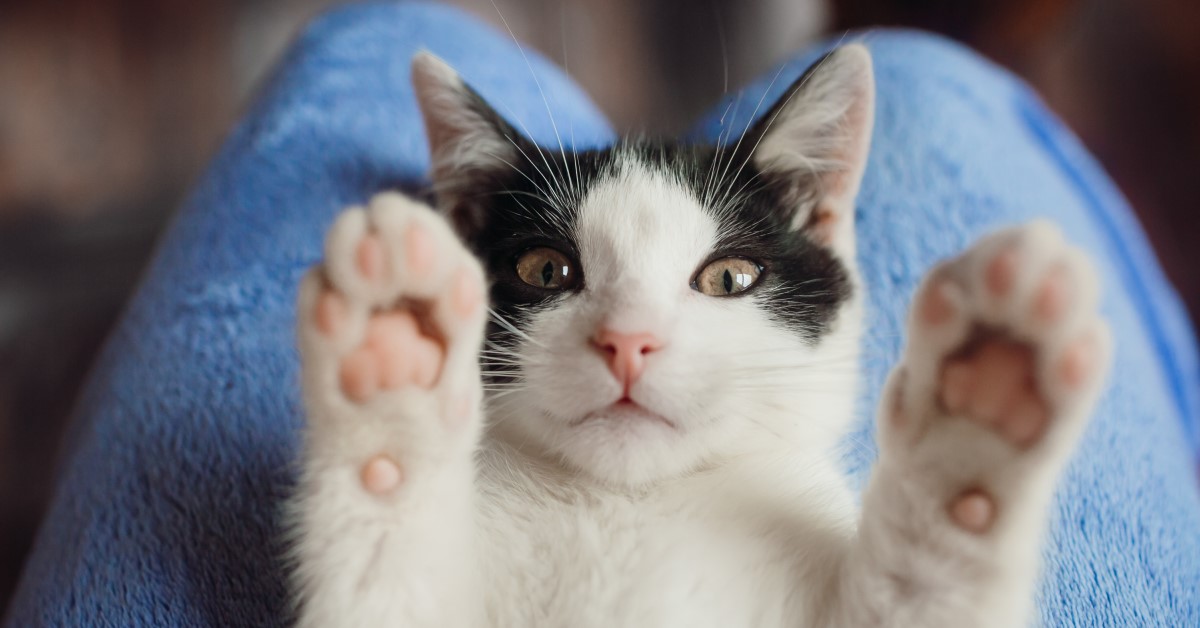Ingrown Nails in Cats: How to Spot Them
Overgrown nails in cats can sometimes result in painful ingrown nails that require swift attention to prevent infection.

Cat claws are made of keratin, a type of protein that makes up your skin, hair, and nails. As it grows, the outer layer of the nail begins to lose its blood supply and sheds, leaving behind a healthier, sharper claw. According to Dr. Roy Brenton Smith, DVM, of the Central Texas Cat Clinic, the average housecat sheds its claws every two to three months.
While this natural nail-shedding process usually goes smoothly, there is a risk that the claw doesn’t come off and becomes ingrown. An ingrown nail will start to curve and push into the skin. When this happens, you may discover the claw stuck in your cat’s toes or pad. Ingrown nails in cats can be a painful condition and should be treated as soon as possible.
Ingrown nails in cats, also known as onychocryptosis, can often be prevented with proper claw care. Learn more about ingrown nails in cats, how to spot them, and what you can do to prevent this condition.
What is an Ingrown Cat Claw?
Ingrown toenails are a common condition in both cats and dogs. Your pet’s nails are constantly growing and when they do not wear down naturally through exercise or get trimmed, they can grow too long. The longer a nail grows, the higher the risk that it will begin to curve and circle back toward the paw. This can cause the claw to grow into the paw pads, which can be quite painful for your cat. If the problem isn’t dealt with in a speedy manner, the paw could become infected.
What are the Symptoms of an Ingrown Cat Claw?
The signs that your cat has an ingrown claw may be subtle at first. If the ingrown claw is causing discomfort, your cat may favor one leg over the other or may even limp to prevent walking on the affected leg. In addition to visible pain, your cat may have other symptoms that could signify an inground nail. These include:
- Discoloration of the nail
- Bleeding
- Pus discharge
- Excessive licking of the paws
- Swelling and inflammation around the nails
- Abnormal claw appearance
How to Treat an Ingrown Cat Claw
While an ingrown claw can be uncomfortable for your pet, this condition is usually not life-threatening. If the claw is only slightly overgrown, you may be able to trim it at home to prevent it from causing more harm. Use pet nail clippers available at most pet stores to trim the overgrown nail just above where it grows into the cat’s paw. The tip of the nail should then fall out of the pad or can be gently extracted using tweezers.
Once the claw is removed from the pad, wash the pad with warm water and a mild antiseptic to clean the wound and prevent infection. If the pad appears irritated, give your cat a warm salt foot bath to help speed up the healing process. If your cat appears agitated with this treatment, wrap him firmly in a towel with only the affected paw exposed.
If the ingrown nail is severely embedded into the pad or if there are already signs of infection, such as redness, pus discharge, or swelling, schedule a visit to your vet’s office for professional treatment. Your vet may trim any excess hair around your cat’s paws and cut the nails. The ingrown nail will then be safely removed from the pad and the wound will be cleaned. Your vet may also prescribe antibiotics to prevent infection.
How to Prevent Ingrown Nails in Cats
There are several things that pet owners can do to help prevent ingrown claws in cats. First, give your cat regular nail trims. Ideally, your cat’s claws should be examined and trimmed every four to six weeks on average. This can vary based on your cat’s age, breed, and lifestyle. If you are not comfortable trimming your pet’s nails, schedule regular visits to your vet’s office or local groomer.
Next, take the time to give your cat some nail care at home. If your cat has long hair, carefully trim the excess fur between the toes to expose the paw pads and nails. Again, if you are uncomfortable doing this yourself, bring your cat to the vet’s office or groomer. You should also visually examine your cat’s paws on a regular basis to look for signs of problems, such as nail overgrowth, bleeding, inflammation, or sensitivity.
While there is no way to prevent your cat’s nails from continuing to grow, you can help keep them at a healthy length. Regular exercise is key to helping to keep your cat’s claws short. Walking or running on abrasive surfaces, such as asphalt and concrete, can help gradually grind down your pet’s nails.
When to Consult with Your Vet
If your cat’s ingrown claw has just started to make contact with the pad, you can typically resolve this problem at home by trimming the nail and cleaning the pad. However, you’ll want to make an appointment with your vet if you are unable to trim your cat’s overgrown nails, the ingrown nail is bleeding, or the pad shows signs of infection, such as swelling, oozing, or feeling warm to the touch.
Ready to start saving money on pet wellness care?
Then take a look at Mint Wellness, the pet wellness plan that provides fast reimbursement on routine pet care. Save on vaccinations, wellness exams, preventatives, dental, and more!
Learn More


